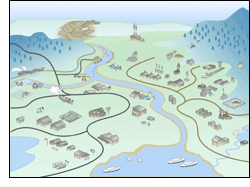RCRA vs. CERCLA:
 How do RCRA and CERCLA differ?
How do RCRA and CERCLA differ?The main difference between the Resource Conservation and Recovery Act of 1976 (RCRA) and the Comprehensive Environmental Response, Compensation, and Liability Act of 1980 is that RCRA is an approach to manage solid and hazardous waste at facilities that are currently in use while CERCLA is focused on the management and remediation of abandoned, non-operating sites with media contaminated with hazardous substance. Unlike CERCLA, RCRA facilities' owners and operators are known and are currently using, managing, or disposing of hazardous wastes. RCRA also regulates the transport of hazardous waste.
Contaminants of Concern:
CERCLA hazardous substances, by definition, are more comprehensive and contain all RCRA defined hazardous substances. RCRA is defined by hazardous "wastes" because it manages the disposal and storage of facilities and generators currently in operation. CERCLA is defined by hazardous "substances" because the hazardous substances found at a contaminated site may or may not be defined as hazardous "waste." Table 302.4 in 40 CFR 302 shows all hazardous substances along with the RCRA designated wastes.For contaminants listed under RCRA see:
Resource Conservation & Recovery Act Page
For contaminants listed under CERCLA see:
Superfund CERCLA Page
Implementing Solutions:
Please submit your experiences (successes/challenges) and tribal-specific documents to share on our website using the attached form.Download Form
Resources:
EPA_CERCLA.pdf [pdf]DOE_RCRAvsCERCLA Comparison.pdf [pdf]
40 CFR 302.pdf [pdf]
RCRAvsSuperfund.pdf [pdf]
RCRAvsSuperfund_factsheet.pdf [pdf]
Websites:
Related Pages:
Resource Conservation & Recovery Act PageSuperfund CERCLA Page
For more information, please contact:
Jennifer Williams, Alaska Program Coordinator, Sr.
Tel: 928/523-0673
Email: Jennifer.Williams@nau.edu
Tel: 928/523-0673
Email: Jennifer.Williams@nau.edu
Last updated: July 10, 2015
